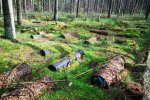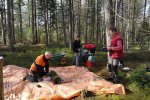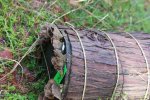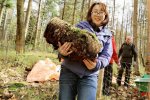
Project
Afterlife of the woods (LOGLIFE)
Deadwood decomposition has been relatively well studied, but how various decomposition drivers interact with each other and how these interactions contribute to wood decay are still unclear. Therefore, we aim to investigate the interactions among tree traits, fungi decomposers and environmental factors and how do such interactions affect stem decomposition.
Background
Dead wood is a source of life; it provides a habitat and substrate for insects and fungi, and it plays an important role in the local and global carbon and nutrient cycle when carbon and nutrients, locked up in dead wood, becomes available through decomposition. A large part of forest biodiversity is associated with deadwood; for example, Dutch forests contain only around 40 shrub and tree species, but as much as 1250 species of wood-inhabiting fungi (REF). The crucial role of dead wood for biodiversity and ecosystem functioning has been recognized by forest managers, and since the 1980s the amount of dead wood in Dutch forests has increased steadily. However, up to now, most emphasis has been given to the quantity rather than the quality of dead wood. The question is how tree species and their wood traits shape the diversity and structure of fungal communities, and how these fungal communities, in turn affect wood decomposition rates and biogeochemical cycling?
Objectives
This research aims to investigate the interactions among tree functional traits, fungi decomposers, as well as environmental factors and how do such interactions affect stem decomposition. We will do so, by taking advantage of a unique experiment (LOGLIFE), in which logs of 24 temperate tree species have been incubated in a common garden experiment in a Dutch temperate forest. We will first quantify the physical and chemical traits of these tree species, and then assess the diversity and composition of Wood-inhabiting fungi (WIF) in decaying logs via high-throughput sequencing. Finally, we will quantify the decomposition rate of 24 tree and disentangle how biotic and abiotic
Methodology
Stem traits of the initial samples will be quantified. Adjacent to each log, a two-centimeter thick disk was collected at the start and stored. We will quantify, physical-chemical traits of different species, individuals within species and different compartments of the stem (innerwood, outerwood, bark) to test how stem traits vary across and within species and trees, and how these traits correlate with fungal communities, then resulting in different decomposition rates.
Additionally, After 1-year and 4-year’s decomposition samples were collected and stored in freezer (-20 ℃) for fungi analysis. At each harvest, one log from each subplot will be randomly chosen and cut into 2 equal, one part (c.50 cm) moved back into the trial for further invertebrates analysis, and the samples used for fungi molecular analysis will be collected from the other half log. Disk sections of top (T, upper side of log) and bottom (B, soil contact side of log) will be mixed as one sample for each log. From each disk, sawdust samples will be taken using an electric drill in the laboratory. Then high-throughput sequencing will be applied to infer a comprehensive and high-resolution profile of saproxylic fungal communities. DNA will be isolated from 0.15 g fresh weight of sawdust samples using the PowerSoil DNA Isolation Kit according to the manufacturer’s instructions.
Publications
-
Stem traits, compartments and tree species affect fungal communities on decaying wood
Environmental Microbiology (2022), Volume: 24, Issue: 8 - ISSN 1462-2912 - p. 3625-3639. -
Dead wood is a source of life : Stem traits, fungal communities, and stem decomposition of temperate tree species
Wageningen University. Promotor(en): L. Poorter, F. J. Sterck, co-promotor(en): U.G.W. Sass-Klaassen - Wageningen: Wageningen University - ISBN: 9789463959728 -
Dead wood diversity promotes fungal diversity
Oikos (2021), Volume: 130, Issue: 12 - ISSN 0030-1299 - p. 2202-2216. -
Methodology matters for comparing coarse wood and bark decay rates across tree species
Methods in Ecology and Evolution (2020), Volume: 11, Issue: 7 - ISSN 2041-210X - p. 828-838. -
Methodology matters for comparing coarse wood and bark decay rates across tree species



